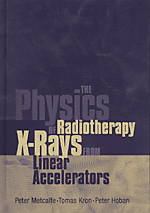
The Physics of Radiotherapy X-Rays from Linear Accelerators (softcover)
Author: Peter Metcalfe, Tomas Kron and Peter HobanISBN: 9780944838761 ISBN10: 0944838766
Published: 1997 | 493 pp | Softcover
OUT OF PRINT
Australasian Radiology | November 1998
"This book has much to warrant its recommendation. The three authors are internationally recognized Australian-based medical physicists. They describe the physical properties and calibration of X-ray beams produced by medical linear accelerators and examine how such beams may best be used to administer radiotherapy to patients, applying the latest dose calculation concepts and in vivo treatment verification tools. One should note that, as the title implies, this text concentrates on radiotherapy X-rays; electron beam therapy is not detailed.
"The chapters follow a logical sequence from the production of x-rays and the principles of operation of linear accelerators, through the dosimetry and properties of therapeutic X-ray beams, to radiotherapy treatment planning which ‘is the process whereby the therapeutic strategy of the radiation oncologist is realized as a set of treatment instructions together with a physical description of the distribution of dose in the patient.' Patient simulation, CT, MRI and other treatment planning aids are explored. Cognisant of the need to deliver a lethal dose to the tumour while minimizing complications arising from the concomitant irradiation of surrounding healthy tissue, the authors not only describe traditional treatment planning methods, but elaborate beyond this, with chapters detailing current developments in photon beam modelling and inhomogeneity corrections using Monte Carlo, and convolution methods of predicting dose distributions due to incident photon beams. This is the future direction of radiotherapy dose planning.
"The authors' coverage of established dosimetric methods extends to the use of the latest thermoluminescent dosimetry (TLD) materials, radiochromic film and metal oxide semi-conductor (MOS) dosimeters. Modern developments, concepts and innovations in other subject areas, such as multileaf collimators, beam's eye view (BEV), dose-volume histograms, computer-aided optimization, continuously hyperfractionated accelerated radiotherapy (CHART) 3-D conformal radiotherapy and electronic portal imaging, are also described.
"The book concludes with a chapter that recognizes that there is more to patient radiotherapy treatment than accurate dose distributions. Radiobiological considerations yield not only the advantage of preferential killing of tumour cells by the fractionation of treatment, but also recognition that there is variation in tumour and normal tissue sensitivity from patient to patient. The authors consider biologically relevant quantities such as cell survival fraction, biologically effective dose, tumour control probability and normal tissue complication probability, and foresee that with ‘the further development of predictive assays to determine tumour sensitivity and proliferation rate as well as normal tissue radiosensitivity, treatment regimens might one day be tailored (optimized) to each patient.' Thus they choose to add a fifth ‘R', for Radiosensitivity, to the established ‘Four R's of Radiobiology' (Reoxygenation, Redistribution, Repair and Regeneration).
"One is impressed by the clarity and ease of reading of the text and illustrations. The book is illustrated with over 200 photos, graphs, tables and line diagrams. At the start of each chapter there is an appropriate quotation; for example, the preface begins with ‘The increase in the average age of the population (i.e. "age hardening"), improved cancer detection and better case reporting will produce a net increase in the incidence of cancer. . . towards a doubling of the radiotherapy caseload by the year 2010 [Jerry Battista, 1996].' There are extensive reference lists at the end of each chapter and a comprehensive index at the rear of the book.
"On the subject areas mentioned here, this book is a valuable reference for
use by medical physicists, radiation oncologists and radiation therapists.
It may have particular relevance for oncology registrars studying the physics
component of the DRACR examination."
James Boehm


